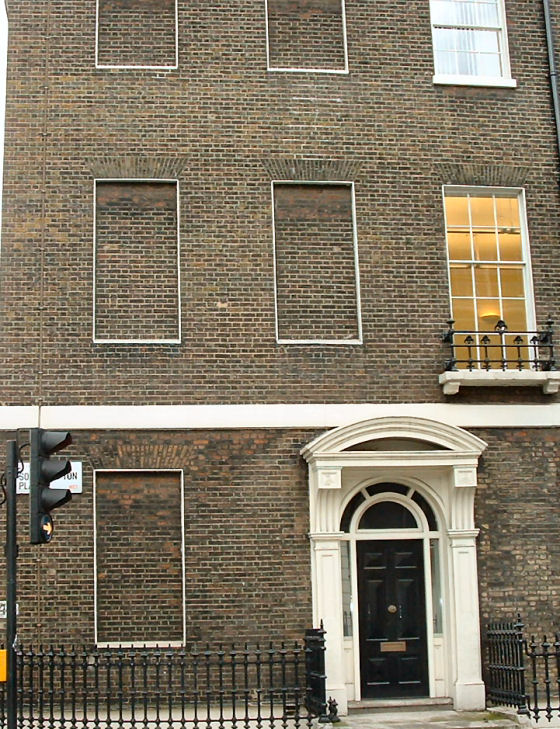
The Coalition’s proposed legislation this week has a marvellously retro feel to it. Sniff the air. Through the whiff of horse dung and open sewers, you can tell we are back in the days of Queen Anne and not solely because the lawfulness of the catholicity of a Monarch’s spouse was an issue deemed worth revisiting.
The Observer noted that a debate in the Lords on the Welfare Reform Bill gave rise to the prospect of the return of the window tax. The glorious proposals to cut the benefits of under-occupiers, so that they have to find a less commodious garrett, gives rise to the question of what constitutes a bedroom for the purposes of under-occupation. Lord Foulkes asked Lord Freud, the minister, whether “a boxroom with a skylight that did not open would be considered a bedroom”. Lord Freud replied that “Boxrooms without opening windows normally would not count as bedrooms.”
 As Lord Foulkes noted, for £20 per week, some tenants may be tempted “to board up their windows, as some owners used to do when there were window taxes”. Lord Freud, apparently not stroking a white cat at the time, replied that the Government would work to stop people taking such action. One can only presume that benefit fraud departments will be checking up on the presence of opening windows, hidden behind plasterboard and faded posters of David Cameron declaring the NHS to be safe in his hands.
As Lord Foulkes noted, for £20 per week, some tenants may be tempted “to board up their windows, as some owners used to do when there were window taxes”. Lord Freud, apparently not stroking a white cat at the time, replied that the Government would work to stop people taking such action. One can only presume that benefit fraud departments will be checking up on the presence of opening windows, hidden behind plasterboard and faded posters of David Cameron declaring the NHS to be safe in his hands.
 Meanwhile Kenneth Clarke, a distinctly 18th Century figure himself, in the style of Gillray or perhaps Rowlandson, has tabled an amendment to the LASPO bill introducing the new crime of trespassing to a residential building with intent to live there. The amendment is here – NC26. Later the same day, the MoJ released the response to the consultation on changes to the law on squatting. The response is here [pdf].
Meanwhile Kenneth Clarke, a distinctly 18th Century figure himself, in the style of Gillray or perhaps Rowlandson, has tabled an amendment to the LASPO bill introducing the new crime of trespassing to a residential building with intent to live there. The amendment is here – NC26. Later the same day, the MoJ released the response to the consultation on changes to the law on squatting. The response is here [pdf].
The amendment covers trespass to a residential building, including a temporary or moveable structure, where residential is defined as “designed or adapted, before the time of entry, for use as a place to live”. The offence is not committed by anyone holding over at the end of a lease or licence, but, as David Smith noted, would potentially be committed by anyone who was invited to stay by someone holding over at the end of a lease or licence. The maximum penalty is 51 weeks, up from the current 6 months for breach of the Criminal Law Act 1977 provisions. There is also a fine of up to £5,000.
The definition of residential building should exclude the concerns that Gypsies and Travellers had about criminalising parking up in the environs of a building (car park, yard etc.) and this would not generally catch occupations by protestors or sit-ins by workers, unless part of the building was residential.
However, this remains a considerable extension of the law that had only criminalised a refusal to leave a property where it was effectively occupied already or was shortly to be.
The consultation response, which is supposed to justify this amendment, is a confused affair, right from Crispin Blunt’s foreword, where after noting that it is already an offence to continue to occupy someone’s home, he promotes the amendment in these terms “But the offence will provide greater protection in circumstances where the harm caused is the greatest – squatting in someone’s home. This behaviour is unacceptable and must be stopped”. Mr Blunt should perhaps have read the response first. In particular the parts pointing out that failure to enforce existing powers by the police was a problem reported in landlords/property owners responses, see Q.19. In addition delays in court timetables and in bailiffs’ appointments were raised by these respondents. This is, of course, a funding issue that is only going to get worse.
The Metropolitan Police, on behalf of ACPO, opposed any change to the current law, while admitting that, well, maybe a bit of training on CLA 1977 wouldn’t go amiss for officers.
The equality impact assessment accompanying the consultation response also concedes that, even after this whole exercise, the MoJ have no real idea about the scale of the problem, or how far it is a problem. They estimate between “200 to 2100 criminal squatting cases in residential property” per annum. That is a broad range, equating to ‘dunno’.
The equality impact assessment notes that, on the basis of the reports prepared for Crisis and others, the proposal would impact disproportionately on the young and the disabled. But, well, tough.
Rather touchingly, the Magistrates Association were particularly concerned about Girl Guides stranded on mountains in bad weather and sought to ensure that any proposals wouldn’t criminalise them for sheltering in a building without permission. The Mags were right to be concerned as the MoJ acknowledge at page 37 that Girl Guides sheltering in a residential building will indeed be caught. Perhaps optimistically, the MoJ hopes that the property owner wouldn’t make a complaint in such circumstances, as the MoJ wasn’t willing to entertain a ‘reasonable excuse’ exemption. That certainly has the smack of the 18th Century, criminalising storm tossed children seeking shelter on the mountainside.
But as so often these days, Deterrence is the sole rationale. The fact that deterrence relies on enforcement, and there is nothing that suggests this would be enforced any more vigorously than s.7 CLA 1977, appears to have escaped our lawmakers. Concerns that a large proportion of squatters are homeless, that there is a shortage of housing and that there are some 700,000 properties left vacant in England are countered with:
Through the Homelessness Ministerial Working Group, the Department for Communities and Local Government, Ministry of Justice and Home Office will work together to ensure that any local enforcement against squatting is carried out in partnership with local homelessness services to mitigate against an associated increase in rough sleeping.
And
The Government wants to increase the number of empty homes that are brought back into use as a sustainable way of increasing the overall supply of housing, and to reduce the perception of neglect that can blight neighbourhoods. Reducing the number of empty homes will also help to reduce incidence of squatting. That is why we have announced £100m capital funding within the Affordable Homes programme to tackle problematic empty homes – that is properties that are likely to remain empty without extra direct financial assistance from government. This programme will deliver at least 3,300 affordable homes by March 2015, as well as engaging local communities in dealing with empty homes in their area.
So, 3,300 homes by 2015 – if that comes off. If the upper estimate of 2100 cases per year is right, that is 6300 people homeless by 2015. A shortfall of 3,000. Not, of course, counting the existing waiting millions.
Oh and there will be a housing strategy shortly.
Crisis and Squash are opposing the amendment as criminalising vulnerable homeless people. See here and here.
Maybe something more 19th Century might be appropriate to finish with. Doré, perhaps. After all, Network Rail did want squatting to railway viaduct arches criminalised in its response to the consultation.

Super Blog – heartbreakingly true.
NL, I can see the art historian in you appearing in this blog! I think the homeless people in the Dore are safe since they are not in a building – a nice message from the government, get out on those streets again.
However a mini campaign did apparently succeed believe it or not. See this extract from draft blog I am working on:
However, a number of groups (including Cardiff Gypsy & Traveller Project, Community Law Partnership, Garden Court Chambers and the New Traveller Association) had pointed out that any definition of a building which included land adjacent to a building might catch Gypsies and Travellers who, especially in urban areas, may have no alternative but to stop on disused land next to a building. We are pleased to report that the Government has listened to these concerns:
The Government noted concerns of groups representing Gypsies and Travellers that any new offence could criminalise Gypsy and Traveller encampments on land ancillary ot the buildings protected by any new offence. Respondents indicated that it was quite common for Gypsies and Travellers to encamp on land outside disused factories and warehouses, particularly in urban areas. The Government has decided to limit the offence to residential buildings, however, and it will not extend to the land ancillary to those buildings at this stage (p.38).
Well done to all those who responded to the consultation on behalf of Gypsies and Travellers.
The campaign against the complete criminalisation of squatting in buildings continues. For more information, contact Squatters Action for Secure Homes (SQUASH) at http://www.squashcampaign.org/
Than you NL, you have just cheered up my Monday morning laughing tears into my coffee. Vic Reeeves couldnt have invented better nonsense. When the laughter subsides of course I shall become very depressed